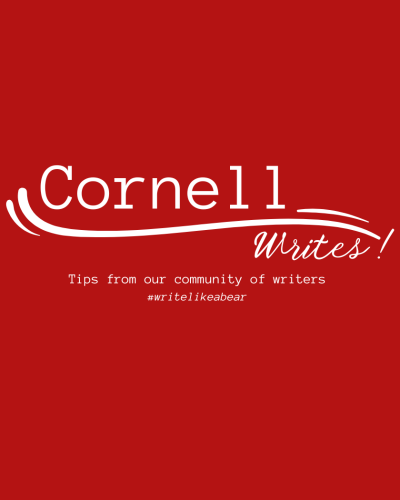Cornell Writes! Tips from our community of writers is a digital newsletter sponsored by the Knight Institute for Writing in the Disciplines and the Cornell University Graduate School.
Each week, a member of our writing community – a Graduate Writing Service, English Language Support Office, or Cornell Writing Centers tutor; a writing specialist from the Knight Institute; a writing instructor from our First-Year Writing Seminars or Writing in the Majors programs; maybe YOU – will share a writing strategy from their own writer’s toolkit. #writelikeabear
Contact Tracy Hamler Carrick with questions and ideas.
Meet Tracy Carrick
Hello Cornell writers! My name is Tracy Carrick. I am a teacher, tutor, and director of the Knight Institute’s Writing Workshop and Graduate Writing Service. I am also a writer and editor. This week, I am writing course descriptions and catching up on email.
Here is this week’s Writing Tip!
Several years ago, I came upon a writing activity that had been, I came to learn, circulating widely and wildly among graduate students across campus. The first version I encountered was a digitized photocopy of a tattered piece of paper that a doctoral student showed me during a writing consultation. The second was handout that I found on the floor as I entered a First-Year Writing Seminar classroom a few weeks later. It was missing its last page.
What was this? Was this the kind of writing tool that could jumpstart, deepen, and clarify my writing and the writing students and colleagues workshop with me? I cobbled together a handout and started sharing it with others.
The exercise seems so simple – pick an artifact that holds special meaning in the context of your research project and carve out time to freely write about it.
I prefer concrete objects, something I can hold or touch, but a fact or process can also work. Be playful and creative! In my current writing course, students are drafting research projects about food (food culture, food systems, food security, and food justice). Some of the artifacts we have selected are: grass-fed beef, a Big Mac, a cowboy hat, a teaspoon of salt, and the calorie.
Once you have your artifact in hand, you are ready to begin responding to a series of questions (see link below) that seek to explicate the often tacit knowledge we hold about objects (and our research) and/or reveal more explicitly what we do not yet know.
When I sat down last week to begin this draft, I googled “implosion exercise” for the first time (How had I NOT done that before?), and I learned that this found tool was actually an adaptation of a 2014 journal article written by Professor Joseph Dumit (Anthropology, UC Davis) titled “Writing the Implosion: Teaching the World One Thing at a Time.”
Dumit’s observation about student outcomes mimics my own, and our shared experience with this process makes me even more enthusiastic about recommending this writing tool to you:
Attending to this process sometimes mutated students’ prior arguments and sometimes deepened them; it also nuanced their understanding of how every argument persists within a field of knowledge threads that are themselves “analytical, imaginative physical, and political choice[s]” (Haraway 1997, 129). From my reading, they became more careful writers, aware of the dimensions they were ignoring and of the limitations of the threads they depended on. (Dumit, emphasis mine)
This tool has teeth! If nothing else, it is a useful writing-adjacent endeavor that can help you move from research to writing. But it can also be much more transformative by reinvigorating your writing process with new through lines and energy. Here are some excerpts from the article to help you get started!
What is an implosion exercise and how do I do it?
As Dumit himself explains:
Implosion Projects are attempts to teach and learn about the embeddedness of objects, facts, actions, and people in the world and the world in them. The emphasis is on details and nonobvious connections, as well as on the many dimensions with which we can analyze them: labor, professional, material, technological, political, economic, symbolic, textual, bodily, historical, educational.
Pick an artifact, a fact, a process as “it.” Make sure it is as specific as possible [...] How can it be conceptualized? What is it to different groups of people and individuals? How is it situated in the world and how is the world situated in it?
With your specific artifact, fact, object, or process in front of you, brainstorm: Go through the list [of questions] slowly and try to answer each question as best you can. Diagram or make a chart if you need to. It may seem hard to know where to put different answers, as the questions are indiscrete.
Follow this link to Dumit’s article and to the exciting collection of questions you can use to brainstorm and unpack your artifact: How Is the World in “It” and How Is “It” in the World? You will also find some additional strategies (I recommend "Brainstorm → Knowledge Map" and "Gap Map → Ignorance Map") for further examining your responses in ways that can both unsettle and distill your thinking.



